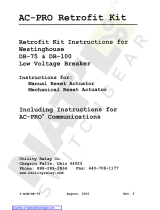
Installation, Operations and Maintenance Manual
3
2.2.1 Receiving
Immediately upon receipt of a G&T device, examine the
cartons to determine if any damage or loss was sustained
during transit. If damage or indication of rough handling is
evident, file a damage claim at once with the carrier and
promptly notify the nearest district office. ABB is not
responsible for damage of goods after delivery to the
carrier. Use care in unpacking to avoid damaging any G&T
device parts.
Unpack the G&T device as soon as possible after receipt.
If unpacking is delayed, difficulty may be experienced in
making a claim for damages not evident upon receipt.
Check the contents of each carton against the packing list
before discarding any packing material. If any discrepancy
is discovered, promptly notify your ABB sales
representative. Information specifying the purchase order
number, carton number and part numbers of damaged or
missing parts should accompany the claim.
2.2.2 Handling
G&T device shipping containers are designed to be
handled by a fork lift. Lifting equipment may be used to
uncrate the device. Lifting provisions are provided. Once
removed from the shipping container, the G&T may be
transported using the lift truck. This is the preferred
transport method.
2.2.3 Storage
Store all equipment indoors in a well-ventilated area. For
G&T devices shipped in crates, store G&T devices upright
in their original shipping carton oriented as indicated on
the shipping crates. If the G&T devices are not placed in
service for some time, it is advisable to provide adequate
means of environmental protection. This may be done by
keeping the G&T device in its original shipping container
and storing in a warm, dry and uncontaminated
atmosphere.
The G&T device should be stored to minimize
condensation. Moisture can cause deterioration of metal
parts and high voltage insulation. Cover with heavy
wrapping paper or other moisture barrier. Use materials
that will not trap moisture inside the unit. Do not cover
louvered open-ings. The storage building should have a
well-drained paved floor. The temperature should be
above 60°F. The air should be dry (approxi-mately 50%
maximum humidity).
Pre-usage inspection and maintenance, if necessary, is
recommended due to the intermittent nature of the usage
of the device. See Section 4 “Maintenance” of this
document for more information.
Courtesy of NationalSwitchgear.com




















